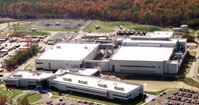






 





|
|
|

240,000
ft2 Project ApproachINTRODUCTION International Commissioning Engineers’ (ICE) approach to how we would ensure that we provide a complete scope of commissioning services that achieves all required objectives, would be to initiate, as soon as possible after award of contract or declaration of intent-to-award, the following actions and / or steps. These steps are modeled after ASHRAE Guideline 1-1996, The HVAC Commissioning Process, the LEEDS Green Building Rating System, and our commissioning experience has shown us time and again that they are both necessary and effective in ensuring that all systems included under the commissioning scope of work operate in accordance with the project documents and the stated design intent of the facility, and meet the State’s operational needs in the most reliable and economical manner obtainable. · Meet with the owner and the design team for purposes of establishing, in so far as it is known at the time, the proposed facility’s design intent and / or the basis of design. · Based upon the established design intent, draw up the preliminary commissioning plan for purposes of delineating all necessary steps in the proposed commissioning process, and for systematically identifying, documenting, reporting, and correcting deficiencies or issues that could prevent “scoped” systems from performing in accordance with the design intent. The preliminary commissioning plan will detail the proposed commissioning activities by phases. The phases utilized will generally follow the phases summarized in ASHRAE’s 1-1996 commissioning guideline, which are as follows: · Program Phase · Design Phase · Construction Phase · Acceptance Phase · Post Acceptance Phase It should be noted that the commissioning plan is not a static document, but a continually developing one that will be revised and modified throughout the construction phase of the project. The commissioning plan will help ensure that the commissioning process achieves the desired end result, i.e. “encompass and coordinate the traditionally separate functions of systems documentation, equipment startup, controls systems calibration, testing and balancing, performance testing and certification, and training”. The importance of the commissioning plan cannot be overemphasized, and it essentially constitutes ICE’s job approach. The commissioning process / job approach that follows is tailored for HVAC / mechanical systems for demonstrative purposes, but it can be expanded and revised as needed to include many other types of commissioning services as well. NARRATIVE A. PROGRAM PHASE (CONCEPTUAL OR PRE-DESIGN PHASE) 1. Assist in development of design intent documents to enable owner to formulate, establish and quantify his goals, objectives, criteria and constraints. 2. Review conceptual design documents to determine owner’s space, functionality, environmental and utility requirements, and the means by which these requirements will be met. 3. Assist in development of preliminary design systems manual that includes the design intent and the basis of design. 4. Assist in development of commissioning scope and preliminary commissioning plan, including itemizing the systems that will undergo commissioning. The preliminary commissioning plan will include preliminary schedules for the following items: initial construction phase commissioning scope meeting; commissioning team planning / progress meetings; “scoped” system field inspections; system / equipment startup checklists and control system point-to-point checkout submittals; functional performance test procedure submittals; system / equipment startup; independent test and balance (TAB), independent electrical field testing and other specialized system testing fieldwork commencement; independent TAB, independent electrical field testing and other specialized system testing performance verification; system functional performance testing; owner training; and issuance of final commissioning report. B. DESIGN PHASE 1. Review intermediate and final design documents to determine their effect on the testing and balancing (TAB) and commissioning process and the overall performance of the HVAC systems, and make enhancement recommendations where appropriate. 2. Items specifically targeted in the design document review include, but are not limited to, the following: a. Location, access to, type and size of volume dampers in the air distribution systems. b. Location, access to, type and size of balancing valves, flow metering stations and automatic flow control valves in the water distribution systems. c. Location of pressure sensors in both air and water distribution systems. d. Building automation system (BAS) controls and related interface with testing and balancing and commissioning procedures. e. BAS controls and the method utilized to maintain specified design minimum fresh air ventilation rate. f. Overall facility pressurization. g. Life safety systems and related BAS interface. h. Equipment maintenance access. i. Specified design equipment and BAS impact on overall system operation, efficient energy utilization and indoor air quality. 3. Assist in development of TAB specification and analyze its impact on the TAB process and overall HVAC system performance. 4. Assist in development of detailed commissioning specification with emphasis given to overall functionality and incorporating experience gained on previous projects. 5. Assist in development of HVAC equipment start-up checklists. 6. Assist in development of verification test procedures for all HVAC systems. 7. Assist in development and scope of functional performance test (FPT) and functional interface test (FIT) specifications for appropriate HVAC systems. C. CONSTRUCTION PHASE 1. Coordinate all commissioning planning meetings and activities in accordance with the preliminary and / or revised commissioning plans and issue meeting agendas and minutes for all commissioning team meetings. The CA will, “coordinate and direct the commissioning activities in a logical, sequential and efficient manner using consistent protocols and forms, centralized documentation, clear and regular communications and consultations with all ” members of the design and commissioning teams. 2. Review HVAC system submittal data for all HVAC components and equipment, all HVAC air and water distribution shop drawings, all BAS schematic drawings and associated system sequences of operation. a. Submittal data shall be reviewed for details that impact both functional compatibility of interfacing components and overall commissioning process. b. Submittal data shall also be reviewed to confirm that the various flow control and metering devices specified have been provided, sized properly to control the specified design flow rates and located where they can perform effectively. c. Submittals shall be specifically reviewed for manufacturer’s recommendations for systems / equipment start-up procedures, performance verification procedures and owner training procedures. 3. Conduct periodic field inspections throughout the construction phase to verify that HVAC systems and equipment are being installed in a manner that will allow the commissioning process to proceed smoothly and compliance with plans and specifications. As an absolute minimum, inspections shall be conducted at the following construction milestones, and shall be documented via a submitted written report noting all pertinent observations and deficiencies. a. HVAC ductwork 60% complete. b. HVAC systems 90% complete. c. HVAC systems 100% complete but prior to ceiling tile installation. 4. Field inspections shall concentrate on the following items. In addition to the items summarized below, field inspections will also seek to verify that suitable precautions are being taken to keep all HVAC ductwork and piping systems / equipment free of dirt and debris as the construction progresses. a. Verify that necessary balancing hardware such as dampers, flow meters, valves, P/T ports, etc. have been installed properly and are readily accessible. b. Identify and evaluate variations from system design that could affect system performance and overall system energy utilization. c. Verify that adequate maintenance access has been provided where needed. d. Verify that the location of pressure sensors in both air and water distribution systems is suitable, and that the sensors are readily accessible. 5. In addition to periodic field inspections, all duct air leakage test (DALT) procedures shall be witnessed on a random basis. All supply, return, exhaust and outside air ductwork/systems should undergo DALT procedures, regardless of pressure class. DALT procedures witnessing shall concentrate on the following items: a. Medium and high pressure duct systems and laboratory exhaust systems shall not have a duct air leakage rate greater than the specified design values. b. Low pressure duct systems shall not have a duct air leakage rate greater than the specified design values. c. Verify that DALT procedures conform to the procedures outlined in the SMACNA HVAC AIR DUCT LEAKAGE TEST MANUAL, and the project design documents. d. Review all recorded DALT procedure data and all duct air leakage rate calculations and determine whether or not the specific duct test section undergoing testing has passed or failed specified design duct air leakage rates. e. Verify that failed duct test sections are resealed and retested until said test section has met specified maximum allowable duct air leakage rates. f. Verify that all duct sections located in duct chases or other inaccessible locations have been tested for duct air leakage and meet specified design duct air leakage rates. 6. Develop system / equipment start-up procedures (for use in preparing start-up checklists) and functional performance test (FPT) procedures based upon final certified equipment submittals and manufacturer’s and installing contractor’s input. a. Correct start-up procedures & checklists are essential in ensuring that equipment and systems are checked out properly before being brought on-line and made operational. Start-up checklists also help ensure that the independent testing phases (i.e. TAB, independent electrical testing, and FPT) of the project proceed smoothly without unnecessary delays. Each piece of equipment must undergo proper start-up procedures, no exceptions. b. Final start-up procedures / checklists shall be derived from a combination of manufacturer’s detailed start-up / checkout procedures, the installing contractor’s normal start-up / checkout procedures and the sample start-up checklists included in the commissioning plan. The final start-up checklists shall include specific boxes or lines for recording and documenting results for each procedure and a signature block at the end of the checklist for certifying the results. c. FPTs shall be derived from a combination of manufacturer’s detailed performance verification procedures, the installing contractor’s normal functional performance procedures and the sample FPTs included in the commissioning plan. The final FPTs shall include specific boxes or lines for recording and documenting results for each procedure and a signature block for certifying the results. 7. Assist in development of schedule for construction and acceptance phase HVAC equipment/system start-up, TAB field work and commissioning activities and integrating these into the overall project schedule. 8. Assist in development of schedule for construction and acceptance phase HVAC equipment/system start-up program and ensuring that TAB field work begins only after the start-up program has been completed. The following items are included under this commissioning function: a. Verify that HVAC equipment start-up check lists have been distributed to all appropriate installing contractors and equipment vendors. b. Verify that applicable construction personnel understand the purpose of the start-up check list is to verify that equipment/systems are truly ready for start-up. All start-up check lists for a given system or piece of equipment must be signed, certified and submitted before that system may be started up. c. Randomly verify the validity of submitted HVAC equipment start-up check lists, and follow up on those systems, which could not be started up because the information on the check list was not accurate. 9. Assist in TAB field work phase of project, particularly in the area of expediting paperwork flow to ensure that identified installation or design related deficiencies reach the appropriate destination, and are addressed in a timely manner. The following items are included under this commissioning function: a. Oversee the TAB field work to verify that all TAB work is conducted in accordance with approved TAB procedures. b. Verify that TAB agency generated deficiency reports have been distributed to appropriate installing contractors, and the design professional (DP) for design related issues, so that immediate attention can be given to addressing and resolving the various deficiencies identified. c. Randomly verify the validity of returned deficiency reports to verify that corrections have been made, and that DP generated recommendations have been implemented. d. Assist in following up on uncorrected deficiency items, and those items, which were inaccurately reported as being corrected, to ensure that all TAB generated deficiency items are resolved, and that final test results can be obtained. e. Verify that final TAB report has been submitted. 10. Issue a summary of all training requirements listed in the project documents for the installing contractor (s) reference. The final training requirements will be established via a submittal review process. The installing contractors should submit, for each system / piece of equipment, a manufacturer’s recommended training procedure. D. ACCEPTANCE PHASE 1. Final TAB report verification a. Randomly select a maximum of 25% of the final TAB report data for performance verification purposes, and oversee TAB agency’s retesting of these items. If 10% or more of the retested items are found to be plus or minus 10% or more out-of-tolerance of published final TAB report values, then the TAB agency shall be liable for retesting part or all of the specific HVAC system before undergoing further performance verification. However, all out-of-tolerance values identified shall be corrected. 2. BAS control input/output (I/O) point-to-point (PTP) termination verification a. All BAS controls will be randomly tested for correct I/O PTP terminations. All invalid PTP terminations shall be corrected. Any specific control system having more than 5% invalid PTP terminations shall be completely rechecked by the controls contractor. 3. Conduct functional performance tests (FPTs) and functional interface tests (FITs) on all previously agreed upon systems and equipment. The following items are included under this commissioning function: a. Verify that all required FPT/FIT preliminary steps have been completed including, but not necessarily limited to, the following: · All BAS control I/O PTP termination verification procedures complete. · All final TAB report verification procedures complete. · FPT procedures are sufficiently comprehensive and straightforward such that repeatable results can be obtained, regardless of the qualified testing agency utilized. · FPT procedures follow a logical, step-by-step, sequential order so that test results are not skewed by untested components on the system. b. Verify that all applicable installing contractors, equipment vendors, general contractor, TAB agency, design team and owner’s maintenance staff personnel are aware of the FPT/FIT schedule and available to begin testing. c. Review FPT/FIT results with design team and verify whether or not specific HVAC systems can be accepted as tested, or if modifications will be required. d. If modifications are required, verify that design team’s recommendations are distributed to all applicable personnel. 4. Consolidate all appropriate project documentation and begin compilation of systems manual. Verify that the following records, certificates, statements, receipts, reports, etc. are available, on file and ready for inclusion into manual. a. Complete set of reproducible drawings indicating as-built conditions of all HVAC systems including automatic temperature controls schematics, piping, ductwork and equipment, incorporating all changes made during construction. b. Record drawings shall include the manufacturer and model number of each major piece of equipment. c. Operation, maintenance and performance data, covering all HVAC components, equipment and systems installed on project. d. Recommended minimum spare parts inventory for major HVAC equipment. e. Documentation verifying completion of training of owner’s maintenance personnel. f. Certification of start-up and acceptable performance of variable speed drives. g. Certification of installation and acceptable performance of vibration isolation for all applicable equipment. h. Certification of hydronic system cleaning. i. Certification of fire pump tests. j. Certification of fire protection piping hydrostatic testing. k. Certification that sprinkler systems are operational. l. Certification of plumbing piping pressure tests. m. Results of domestic water system disinfection tests. n. Certification of cooling tower thermal performance. o. Certification of chiller installation and safety control check-out. p. Certification of proper alignment of all pumps. q. Certification of operation and accuracy of air and water flow measuring stations. r. Certification of DDC system calibration, PTP verification and testing. s. Certification of ductwork and air distribution equipment cleaning. t. Copy of all certified HVAC EQUIPMENT START-UP CHECK LISTS. u. Copy of all submitted TAB agency deficiency reports. v. Certification of all ductwork pressure testing results. w. Certification of all life safety system tests. x. Thorough description of operation for all commissioned systems including all applicable schematics and diagrams. y. Thorough description of all functional performance and verification tests, and all integrated system functional interface tests performed. z. Completed final TAB report including final test results on all air systems, hydronic systems and life safety systems. 5. Verify that training of owner’s maintenance personnel has been properly coordinated among the general contractor, applicable installing contractors, equipment vendors and successfully completed. 6. Submit final commissioning report systems manual. E. POST ACCEPTANCE PHASE 1. Assist owner’s maintenance personnel in establishing the following: a. Maintenance program. b. Ongoing performance monitoring. c. Occupant complaint tracking and response documentation. d. Equipment calibration and/or replacement schedule. e. Schedule of periodic HVAC system functional performance tests. Copyright 2004 - International Commissioning Engineers LLC |